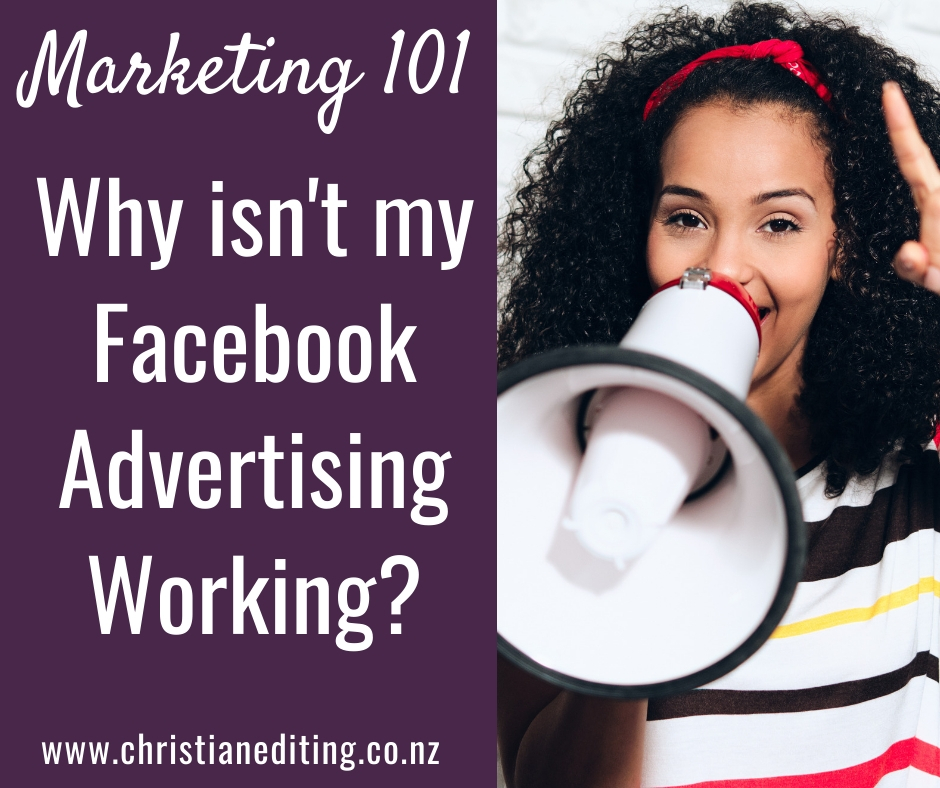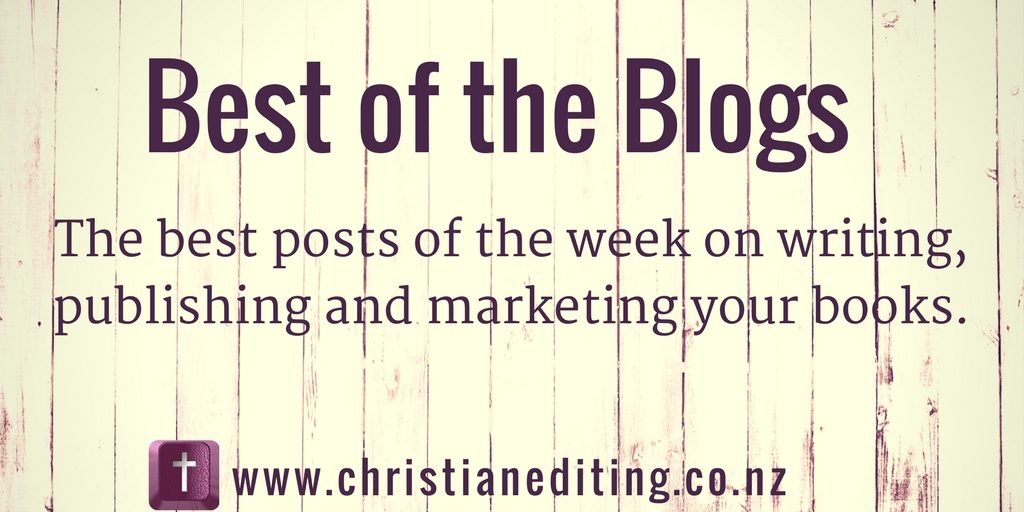Why aren’t my Facebook Advertisements Converting into Sales?
This question came from a Facebook group I’m a member of. The author said they’d spent thousands of dollars advertising their book on Facebook, yet never had an advertisement that actually “worked”.
I’m going to leave aside the obvious question of why someone would spend thousands on advertising with no results.
While I’m no expert on Facebook advertising, the advice I’ve seen is to start at $5 per day and scale up, focussing on repeating and tweaking the advertisements that get results.
If you spend $5 a day for a month (i.e. $150) and get no results, then I think you take a step back to try and figure out what’s not working. You don’t wait until you’ve spent thousands. Surely that’s just common sense.
As my father told me, common sense isn’t that common.
The other issue is the questioner didn’t make clear how they defined “work”.
If we’re advertising on Facebook (or any other media network), then we need to have an objective, and we need to measure our results against that objective. The most common objective is to make sales, and I assume the original questioner was advertising in the hope of making sales. But some authors have run Facebook advertisements to build their email list by offering a free book, or even to boost the effect of a free giveaway. Those are also valid objectives. So was the questioner’s objective to sell books, or build their list? We don’t know.
Leaving those factors aside, and acknowledging that I’m no expert on Facebook advertising, I can see three main reasons why a Facebook advertisement (or series of advertisements) might not “work”:
- The advertisement isn’t engaging the target audience.
- The Amazon book page isn’t engaging viewers.
- The product isn’t up to standard in some way.
Advertising to the Target Audience
I’ve never tried advertising on Facebook, so the little I know comes from the blog posts and social media posts I’ve read on the subject (if you want to know more, I suggest checking out Bryan Cohen, Mark Dawson, or David Gaughran).
What I do know is that Facebook holds a lot of personal information about its users, and authors can target their advertisements based on a range of factors.
Facebook also reports the response from advertising, including how many people have viewed and clicked on each advertisement. What Facebook can’t tell you is how many people who click go on to take action (e.g., buy the advertised book, or sign up for the author’s mailing list, or whatever objective the author had for the advertisement).
If your advertisements aren’t “working”, the first place to look is your Facebook statistics.
How many people viewed your advertisement? If no one views your advertisement, then it could be you’re targeting the wrong people, or not paying enough for the advertisements. In that case, ask a Facebook ads expert for advice.
Assuming people do see your advertisement, do they click? How many click? What is the normal percentage of viewers that you can expect to click?
- If people are viewing your advertisement but not clicking, then the problem is probably a mismatch between the people you’re targeting, and the advertising copy. Perhaps you’re targeting British male thriller readers aged 30 to 50, but your advertisement copy appeals more to a female audience.
- If people are viewing and clicking your advertisement at acceptable rate but that isn’t converting to sales (or newsletter signups, or whatever your objective is), then the problem might not be your advertisements.
If the problem isn’t your advertisement, then it might be your Amazon book page.
Amazon Book Page
I’m the curious type, so I checked out the author’s Amazon page—mostly because they specifically stated they had professional covers, brilliant book descriptions, and good reviews. My experience as a reviewer is authors who think their cover, book description, and reviews are all brilliant does not make it so.
I was right. (Sometimes I hate that.)
(I’m not the first person to point out that if a book isn’t selling, the problem is likely to be the book. For example, see this excellent post from Kristen Lamb: It Isn’t the Reader, It’s the Book … Really.)
The author had three books on sale—two novels in a series, and a nonfiction title. I looked at the first novel in the series.
The novel had an intriguing juxtaposition in the title, but the subtitle was confusing. It implied this was a standalone novel, but also part of a series. On one hand, I can see why the author mentioned it was a standalone novel—they were trying to make clear this was a complete story, and didn’t have a cliffhanger ending. That’s good—a lot of readers (including me) loathe cliffhanger endings. But I think this would have been better stated in the book description than the subtitle. Leave the subtitle to tell the reader what they need to know: [book title] is the first book in the [series name] series.
I liked the cover. But that’s not necessarily a good thing.
The book was supposed to be a hardboiled thriller, and I mostly read sweet and Christian romance, and romantic suspense. There’s a big difference between a female-led romantic suspense novel and a hardboiled thriller with a male lead. A reader should be able to look at the cover and know which they’re getting. In this case, the cover looked more like a female-led romantic suspense novel than a hardboiled thriller.
The book description needed work. My editor brain noticed all the unnecessary capital letters and missing hyphens. Other commenters noted telling, mixed tenses, overlong sentences, unnecessary information (like the weather), and an excessive use of passive voice (passive voice isn’t a great way to sell any novel, let alone an action novel).
Title, cover, description. All bad.
That’s three strikes. Already. And we haven’t even looked at the reviews or the first page yet.
The book only had eleven reviews, and the top three featured reviews were three, two, and one-star. That’s hardly “good”. Those three reviews all commented that the first quarter was very slow, and the story didn’t get going until halfway through. That structure can work in literary fiction or women’s fiction. It won’t work for a so-called thriller, where readers expect compelling action from page one (like in a James Bond movie).
The book was relatively expensive for the first book in a series from an unknown author—$4.99 for 300 pages. That’s not overpriced (unlike the author’s nonfiction title, which was $4.99 for 69 pages). But I suspect it’s more common for authors to use Facebook advertising for first-in-series books on sale at $2.99 or even 99 cents. The idea is that a loss leader will entice the reader into buying the full-priced sequel. People who click through to Amazon are likely to look at the price, and click away.
At this point, I doubt many readers are going to consider reading the Look Inside or the Kindle sample. If they do, then they’ll make their purchase decision based on the quality of the opening pages.
Product Quality
The formatting of the book looked fine, with a readable font, a drop capital at the beginning of the chapter, and a nice (if geographically vague) graphic between the chapter head and the text. But the chapters had names, and that’s not something I see in modern fiction for adults. It suggests the author doesn’t know or understand current trends in fiction … which is not a good sign.
The story opened with the point of view character waking up alone in his London flat. There are two problems with this opening:
- It’s considered a cliche for a novel to start with a dream, with the character waking up, or with the character at a funeral. A clever writer can twist the cliche in to something original and compelling. This opening was neither original nor compelling.
- Any time there is only one character in a scene, there is a good chance the scene will be telling rather than showing. This scene was told. And told. And told.
Cliche aside, I’d decided by page two that I didn’t like the point of view character.
He complains about the “badly behaved foul-mouthed children” then comments about how he hates being wakened by that “****ing racket”. Pot, meet kettle. As I said, I’m not the target reader for a hardboiled thriller (whose readers probably expect this language).
But let’s leave my personal preferences aside and focus on the writing.
We have a one-sentence summary of the previous night (telling), and a too-detailed description of our hero’s morning routine (more telling, and no action. Unless you count getting out of bed slowly as action).
We then have the cliche scene of the character looking in the mirror to discover what he looks like (tired, probably a result of last night’s beer).
We have direct thought in italics. Direct thought in italics isn’t incorrect, but does suggest the author doesn’t know how to use interior monologue correctly.
He then has breakfast (in summary, fortunately), before swearing a bit more and checking his calendar to see what he’s doing today. Yes, more telling.
Then we have some backstory, and I gave up reading about the time he inexplicably decided to drive from Seven Sisters to Finsbury Park instead of taking the tube (it’s only one stop).
Suffice to say, I congratulate anyone who gets through the Kindle sample. They are a better person than I am.
The sad thing is that all of this could have been addressed by a manuscript assessment or edit from a competent editor. It would have cost money, sure. Perhaps even thousands. But less than the thousands the author has spent on advertising.
It’s not that this author’s Facebook advertising didn’t “work.”
It’s that the author has spent their time and money on advertising an overpriced product that doesn’t fit the market. Instead, that time and money should have been spent on improving the product.
If your Facebook advertisements aren't working, ask yourself: are the advertisements the problem? Or is it the book? #WritingCommunity #BookMarketing Share on XAnd that’s the lesson.
It doesn’t matter how good your cover is, or how much you spend on advertising (on Facebook or elsewhere). If your basic product (book) doesn’t shine, then no one is going to buy it.




